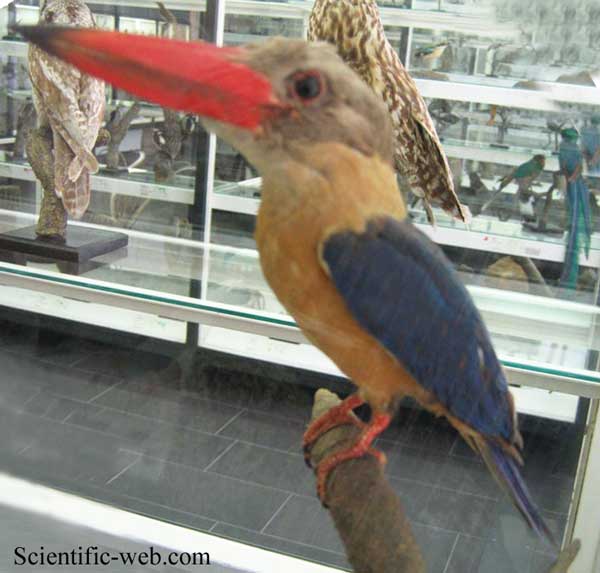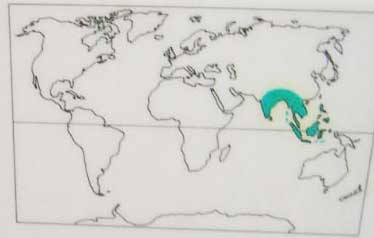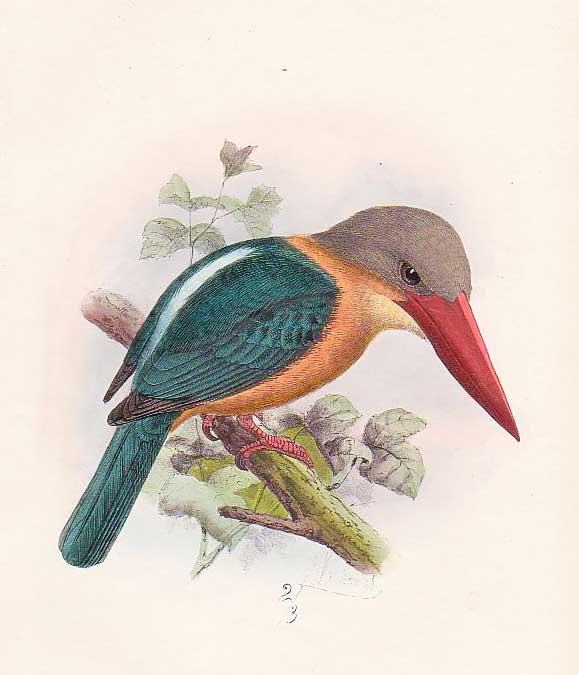
Pelargopsis capensis , Photo: Michael Lahanas
Superregnum: Eukaryota
Cladus: Unikonta
Cladus: Opisthokonta
Cladus: Holozoa
Regnum: Animalia
Subregnum: Eumetazoa
Cladus: Bilateria
Cladus: Nephrozoa
Superphylum: Deuterostomia
Phylum: Chordata
Subphylum: Vertebrata
Infraphylum: Gnathostomata
Megaclassis: Osteichthyes
Cladus: Sarcopterygii
Cladus: Rhipidistia
Cladus: Tetrapodomorpha
Cladus: Eotetrapodiformes
Cladus: Elpistostegalia
Superclassis: Tetrapoda
Cladus: Reptiliomorpha
Cladus: Amniota
Classis: Reptilia
Cladus: Eureptilia
Cladus: Romeriida
Subclassis: Diapsida
Cladus: Sauria
Infraclassis: Archosauromorpha
Cladus: Crurotarsi
Divisio: Archosauria
Cladus: Avemetatarsalia
Cladus: Ornithodira
Subtaxon: Dinosauromorpha
Cladus: Dinosauriformes
Cladus: Dracohors
Cladus: Dinosauria
Cladus: Saurischia
Cladus: Eusaurischia
Subordo: Theropoda
Cladus: Neotheropoda
Cladus: Averostra
Cladus: Tetanurae
Cladus: Avetheropoda
Cladus: Coelurosauria
Cladus: Tyrannoraptora
Cladus: Maniraptoromorpha
Cladus: Maniraptoriformes
Cladus: Maniraptora
Cladus: Pennaraptora
Cladus: Paraves
Cladus: Eumaniraptora
Cladus: Avialae
Infraclassis: Aves
Cladus: Avebrevicauda
Cladus: Pygostylia
Cladus: Ornithothoraces
Cladus: Ornithuromorpha
Cladus: Carinatae
Parvclassis: Neornithes
Cohors: Neognathae
Cladus: Neoaves
Ordo: Coraciiformes
Familia: Alcedinidae
Subfamilia: Halcyoninae
Genus: Pelargopsis
Species: Pelargopsis capensis
Subspecies: P. c. burmanica - P. c. capensis - P. c. cyanopteryx - P. c. floresiana - P. c. fraseri - P. c. gigantea - P. c. gouldi - P. c. inominata - P. c. intermedia - P. c. isoptera - P. c. javana - P. c. malaccensis - P. c. nesoeca - P. c. osmastoni - P. c. shekarii - P. c. simalurensis - P. c. smithi - P. c. sodalis
Name
Pelargopsis capensis (Linnaeus, 1766)
References
Systema Naturae ed.12 p. 180
Vernacular names
বাংলা: মেঘহও মাছরাঙা
čeština: Ledňáček gurial
Deutsch: Storchschnabelliest
English: Stork-billed Kingfisher
Esperanto: Cikonibeka arbalciono
español: Alción picocigüeña
français: Martin-chasseur gurial
Bahasa Indonesia: Pekaka Emas
മലയാളം: കാക്ക മീന്കൊത്തി
Bahasa Melayu: Burung Pekaka Paruh Pendek
中文: 鹳嘴翡翠


Pelargopsis capensis burmanica
The stork-billed kingfisher (Pelargopsis capensis), is a tree kingfisher which is widely but sparsely distributed in the tropical Indian subcontinent and Southeast Asia, from India to Indonesia. This kingfisher is resident throughout its range.
Taxonomy
P. c. capensis at Ranthambore National Park
The first formal description of the stork-billed kingfisher was by the Swedish naturalist Carl Linnaeus in 1766 in the 12th edition of his Systema Naturae. He coined the binomial name Alcedo capensis.[2] Linnaeus based his description on Mathurin Jacques Brisson's "Le martin-pescheur du Cap de Bonne Espérance". Brisson believed his specimen had come from the Cape of Good Hope region of South Africa.[3] The species does not occur in Africa and it was suggested that the specimen had been obtained on the Indonesian island of Java.[4][5][6] The specimen is now known to have come from near Chandannagar in West Bengal, India.[7][8] Linnaeus's specific epithet capensis denotes the Cape of Good Hope.[9] The current genus Pelargopsis was introduced by the German zoologist Constantin Gloger in 1841.[10]
Thirteen subspecies are recognised:[11]
P. c. capensis (Linnaeus, 1766) – Nepal through India to Sri Lanka
P. c. osmastoni (Baker, ECS, 1934) – Andaman Islands
P. c. intermedia Hume, 1874 – Nicobar Islands
P. c. burmanica Sharpe, 1870 – Myanmar to Indochina and south to north Malay Peninsula
P. c. malaccensis Sharpe, 1870 – central and south Malay Peninsula, Riau Archipelago and Lingga Islands
P. c. cyanopteryx (Oberholser, 1909) – Sumatra, Bangka Island and Belitung Island
P. c. simalurensis Richmond, 1903 – Simeulue Island (off the west coast of the island of Sumatra in Indonesia)
P. c. sodalis Richmond, 1903 – Banyak, Nias, Batu and Mentawai Islands (off the west coast of Sumatra)
P. c. innominata (van Oort, 1910) – Borneo
P. c. javana (Boddaert, 1783) – Java
P. c. floresiana Sharpe, 1870 – Bali to Flores (Lesser Sunda Islands)
P. c. gouldi Sharpe, 1870 – north Philippines
P. c. gigantea Walden, 1874 – central and south Philippines
The insular forms nesoeca on the Nias and Batu Islands as well as isoptera on Mentawai Island are here subsumed within sodalis. Prior to the change of type locality to Chandannagar, the birds in India were placed in the subspecies gurial but this race is now synonymized with the nominate race capensis.[8]
Description
It is a very large kingfisher, measuring 35 cm (14 in) in length.[12] The adult has a green back, blue wings and tail, and olive-brown head. Its underparts and neck are buff. The very large bill and legs are bright red. The flight of the stork-billed kingfisher is laboured and flapping, but direct. Sexes are similar. There are 13 races or subspecies, differing mostly in plumage detail, but P. c. gigantea of the Sulu Archipelago in the Philippines has a white head, neck and underparts.
Habits
The stork-billed kingfisher lives in a variety of well-wooded habitats near lakes, rivers, or coasts. It perches quietly whilst seeking food, and is often inconspicuous despite its size. It is territorial and will chase away eagles and other large predators. This species hunts fish, frogs, crabs, rodents and young birds.
Adults dig their nests in river banks, decaying trees, or tree termite nests. A clutch of two to five round white eggs is typical.
The call of this noisy kingfisher is a low and far reaching peer-por-por repeated about every 5 seconds, as well cackling ke-ke-ke-ke-ke-ke.[13]
References
BirdLife International (2016). "Pelargopsis capensis". IUCN Red List of Threatened Species. 2016: e.T22683227A92979065. doi:10.2305/IUCN.UK.2016-3.RLTS.T22683227A92979065.en. Retrieved 11 November 2021.
Linnaeus, Carl (1766). Systema naturae : per regna tria natura, secundum classes, ordines, genera, species, cum characteribus, differentiis, synonymis, locis (in Latin). Vol. 1, Part 1 (12th ed.). Holmiae (Stockholm): Laurentii Salvii. p. 180.
Brisson, Mathurin Jacques (1760). Ornithologie, ou, Méthode contenant la division des oiseaux en ordres, sections, genres, especes & leurs variétés: Supplement d'Ornithologie. Vol. 4. Paris: Jean-Baptiste Bauche. p. 488, Plate 36 Fig. 3.
Sharpe, R.B. (1870). "On the genus Pelargopsis, Gloger". Proceedings of the Zoological Society of London: 61–69 [66].
Oberholser, Harry C. (1909). "Revision of the kingfisher genus Ramphalcyon (Pelargopsis)". Proceedings of the United States National Museum. 35 (1657): 657–680 [663–665]. doi:10.5479/si.00963801.1657.657.
Peters, James Lee, ed. (1945). Check-list of Birds of the World. Vol. 5. Cambridge, Massachusetts: Harvard University Press. p. 187.
Stresemann, Erwin (1952). "On the birds collected by Pierre Poivre in Canton, Manila, India and Madagascar (1751–1756)". Ibis. 94 (3): 499–523. doi:10.1111/j.1474-919X.1952.tb01847.x.
Woodall, P.F.; Kirwan, G.M. (2017). del Hoyo, J.; Elliott, A.; Sargatal, J.; Christie, D.A.; de Juana, E. (eds.). "Stork-billed Kingfisher (Pelargopsis capensis)". Handbook of the Birds of the World Alive. Lynx Edicions. Retrieved 10 June 2017.
Jobling, James A. (2010). The Helm Dictionary of Scientific Bird Names. London: Christopher Helm. pp. 89–90. ISBN 978-1-4081-2501-4.
Gloger, Constantin Wilhelm Lambert (1842). Gemeinnütziges Hand- und Hilfsbuch der Naturgeschichte (in German). Breslau: A. Schulz. p. 338.
Gill, Frank; Donsker, David, eds. (2017). "Rollers, ground rollers & kingfishers". World Bird List Version 7.2. International Ornithologists' Union. Retrieved 28 May 2017.
Ali, Sálim (1996). The Book of Indian Birds (12th ed.). Bombay: Bombay Natural History Society. ISBN 0-19-563731-3.
Fry, C.Hilary; Fry, Kathie; Harris, Alan (2000). Kingfishers, Bee-eaters, and Rollers. London, Eng.: Christopher Helm Publishers. pp. 137–139. ISBN 978-0-7136-5206-2. Retrieved 11 April 2016.
External links
Retrieved from "http://en.wikipedia.org/"
All text is available under the terms of the GNU Free Documentation License

